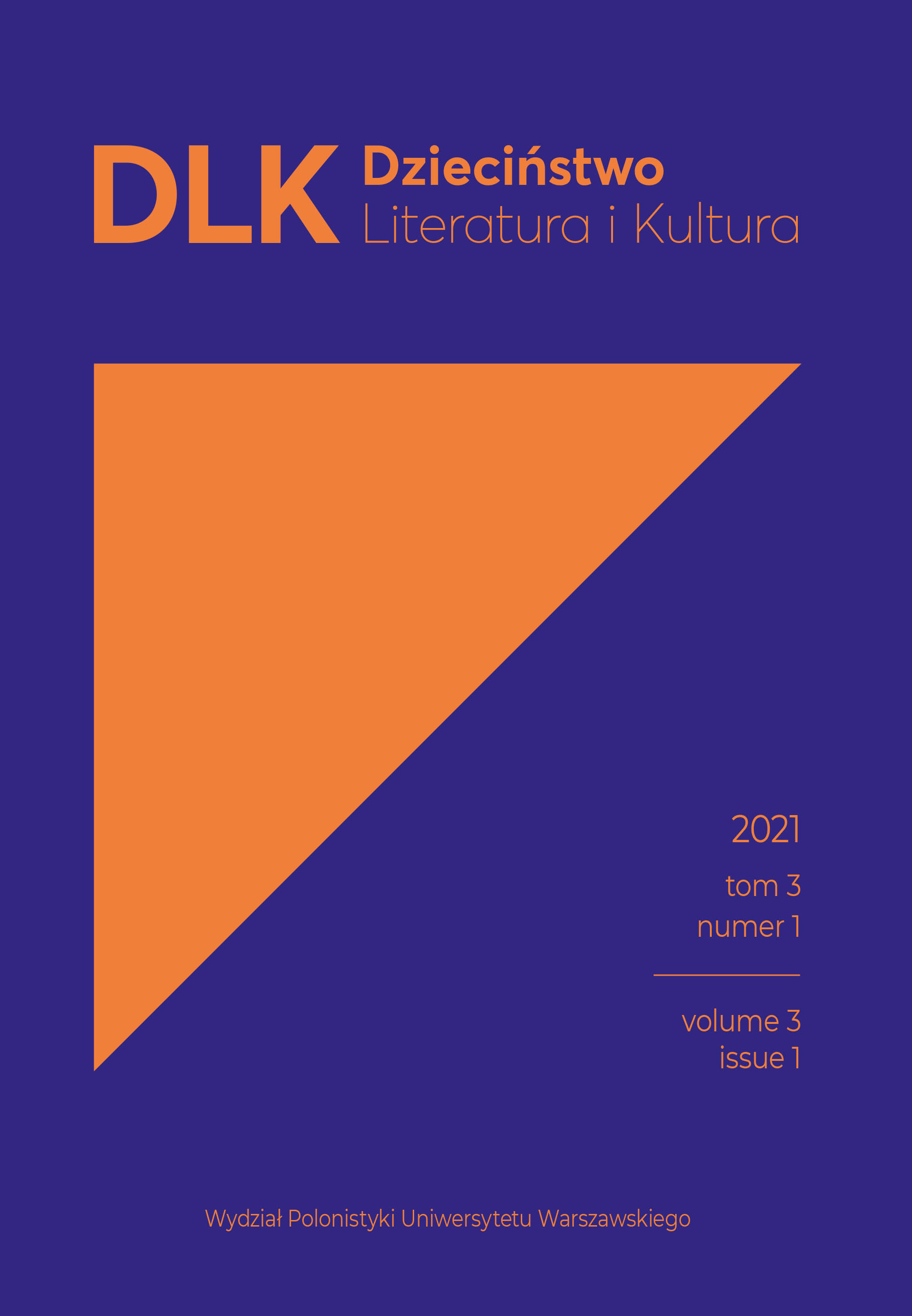Diversity and Multiculturalism in the Detektywi na kółkach Series by Marcin Kozioł
Abstract
The aim of this paper is presentation of the way of describing diversity and multiculturalism in the Detektywi na kółkach [Detectives on Wheels] book series by Marcin Kozioł. This series consists of three books: Skrzynia Władcy Piorunów [The Lord of The Thunders’ Chest] (2017), Tajemnica Przeklętej Harfy [The Secret of the Cursed Harp] (2018) and Gwiazda Blachonosego [The Plate-Nose’s Star] (2020). The author of the article first examines problems related to the representation of diverse value systems and cultures in contemporary Poland, including invisibility of particular types of diversity (like different than dominant religion or neurodiversity). She then moves on to analyse multiple aspects of multiculturalism in the series written by Marcin Kozioł. Based on these analyses, it can be concluded that the way of describing social diversity in these three novels represents a transitional stage between traditional representations of this topic and sensitivity of readers in the 21st century.
Received: 06.01.2022
Accepted: 25.03.2022
Keywords
Detektywi na kółkach [Detectives on Wheels]; Marcin Kozioł; disability; Polish children’s literature; diversity; multiculturalism; multiculturality
References
Andrzejczak, H. (2008). Między ckliwym moralizatorstwem a pobożnym przeżyciem. W: K. Heska-Kwaśniewicz (red.), Literatura dla dzieci i młodzieży (po roku 1980) (s. 136–157). Wydawnictwo UŚ.
Boguszewski, B. (oprac.). (2015). Kanon wiary Polaków. Komunikat z badań CBOS,29, 1–11.
Davis, L. J. (2013). The end of normal: Identity in a biocultural era. The University of Michigan Press.
Fidowicz, A. (2020). Niepełnosprawność w polskiej literaturze XX i XXI wieku dla dzie ci i młodzieży. Wydawnictwo UJ.
Fornalczyk-Lipska, A. (2017). Odmienność narodowa i etniczna w najnowszej polskiej literaturze dla młodego odbiorcy a wyzwania edukacji międzykulturowej. Kultura i Edukacja, 115(1), 15–30. https://doi.org/10.15804/kie.2017.01.01.
Hallamish, M. (1999). An introduction to the Kabbalah. State University of New York Press.
Hamam, K. (2014). Confining spaces, resistant subjectivities: Toward a metachronous discourse of literary mapping and transformation in postcolonial women’s writing. Cambridge Scholars.
Harrison, P. (2012). Profane Egyptologists: The revival and reconstruction of ancient Egyptian religion. University College London.
Issitt, M., Main, C. (2014). Hidden religion. The greatest mysteries and symbols of the world’s religious beliefs. ABC-CLIO.
Kasdepke, G. (2020). Mrówki. W: K. Oponowicz (red.), Wszystkie kolory świata. Agora.
Keown, D. (2013). Buddhism: A very short introduction. Oxford University Press.
Kitchens, B., Johnson, S. L., Gray, P. (2020). Understanding echo chambers and fil ter bubbles: The impact of social media on diversification and partisan shifts in news consumption. MIS Quarterly, 44(4), 1619–1649. https://doi.org/10.25300/MISQ/2020/16371.
Kostecka, W. (2021). Nadzieja dla „Innego”. Kategoria „inności” w polskiej wielokulturowej literaturze dla młodych odbiorców. Paidia i Literatura, 3, 1–15. https://doi.org/10.31261/PiL.2021.03.03.
Kozioł, M. (2014). Skrzynia Władcy Piorunów. The Facto.
Kozioł, M. (2017). Tajemnica Przeklętej Harfy. Prószyński i S-ka.
Kozioł, M. (2020). Gwiazda Blachonosego. Prószyński i S-ka.
Kymlicka, W. (2015). Solidarity in diverse societies: Beyond neoliberal multiculturalism and welfare chauvinism. Comparative Migration Studies, 3, 17. https://doi.org/10.1186/s40878-015-0017-4.
Lee, E. (2019). America for Americans. A history of xenophobia in the United States. Basic Books.
Leeuwen, T. (2020). Synaesthesia and autism: Different developmental outcomes from overlapping mechanisms?. Cognitive Neuropsychology Sponsored Symposium. Po brane 6 stycznia 2022 z: https://www.tandfonline.com/doi/full/10.1080/02643294.2020.1808455.
Nowicka, E., Łodziński, S. (2021). Czy to jeszcze stereotyp? Wizerunek Anglika w społeczeństwie polskim – tradycja i nowa wiedza. Studia Migracyjne. Przegląd Polonijny, 57(1), 101–124. https://doi.org/10.4467/25444972SMPP.21.005.13317.
Panofsky, E. (1955). Meaning in the visual arts. Doubleday.
Peters, E. (1980). Heresy and authority in Medieval Europe. University of Pennsylvania Press.
Pluta, J. (2014). Stereotyp Amerykanina. Preferencja określonych wartości a społeczne postrzeganie cudzoziemca. Opuscula Sociologica, 10(4), 59–70.
Said, E. W. (2018). Orientalizm (M. Wyrwas-Wiśniewska, tłum.). Zysk i S-ka. (wyd. oryg. 1978).
Szczerba, W. (2014). Koncepcja wiecznego powrotu w myśli wczesnochrześcijańskiej i jej greckie źródła. WN UMK.
Tubylewicz, K. (2017). Moraliści. Jak Szwedzi uczą się na błędach i inne historie. Wielka Litera.
Vuletić, A., Živković, T. (2002). Porodica u Srbiji sredinom 19. veka. Istorijski institut.
Wilson, J. (2010). Samsara and rebirth in Buddhism. Oxford University Press.
Jagiellonian University in Kraków Poland
https://orcid.org/0000-0003-3185-5012
Alicja Fidowicz – PhD, works at the Department of International Polish Studies of the Faculty of Polish Studies at Jagiellonian University in Kraków (Poland). Her research interests include disability studies, children’s and young adult literature, and Polish-Slovenian contacts. Contact: alicja.fidowicz@uj.edu.pl.

This work is licensed under a Creative Commons Attribution 4.0 International License.
Open Access Policy
All articles presented on the pages of ”Dzieciństwo. Literatura i Kultura” are published in open access under a Creative Commons license - Attribution 4.0 International (CC BY 4.0). It means that:
- they can be made available and quoted under the condition of explicit and clear indication of the author/authors of the referenced text;
- you cannot use legal or technological means that would limit others in using the text under the terms of the license.
More information: https://creativecommons.org/licenses/by/4.0/





